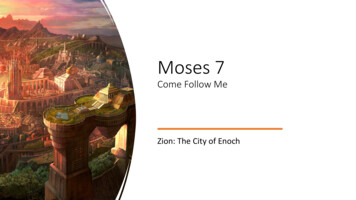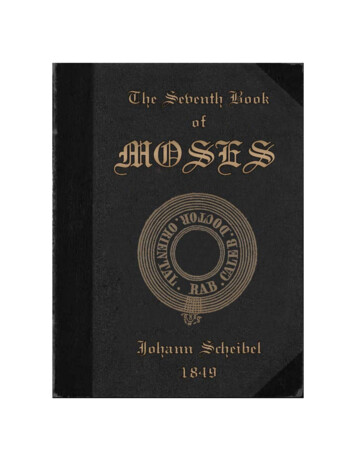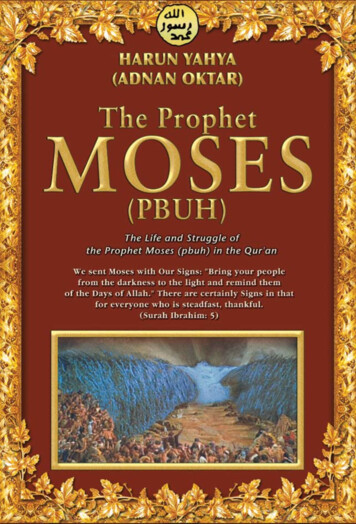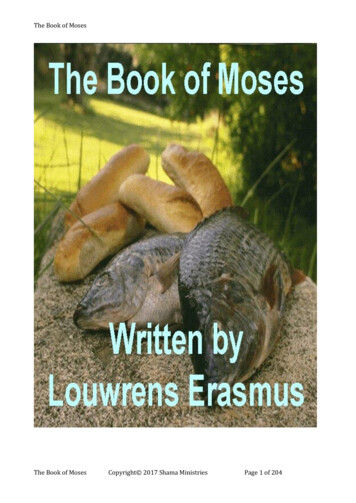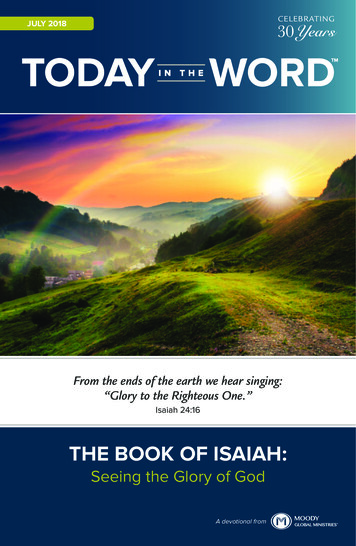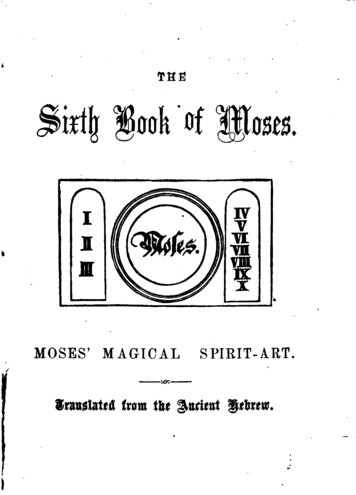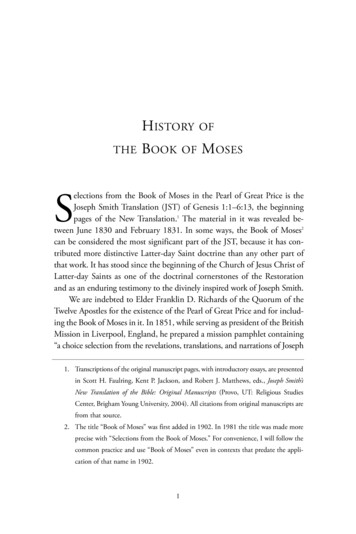
Transcription
THEHISTORYOFBOOKMOSESOFelections from the Book of Moses in the Pearl of Great Price is theJoseph Smith Translation (JST) of Genesis 1:1–6:13, the beginningpages of the New Translation.1 The material in it was revealed between June 1830 and February 1831. In some ways, the Book of Moses2can be considered the most significant part of the JST, because it has contributed more distinctive Latter-day Saint doctrine than any other part ofthat work. It has stood since the beginning of the Church of Jesus Christ ofLatter-day Saints as one of the doctrinal cornerstones of the Restorationand as an enduring testimony to the divinely inspired work of Joseph Smith.We are indebted to Elder Franklin D. Richards of the Quorum of theTwelve Apostles for the existence of the Pearl of Great Price and for including the Book of Moses in it. In 1851, while serving as president of the BritishMission in Liverpool, England, he prepared a mission pamphlet containing“a choice selection from the revelations, translations, and narrations of JosephS1. Transcriptions of the original manuscript pages, with introductory essays, are presentedin Scott H. Faulring, Kent P. Jackson, and Robert J. Matthews, eds., Joseph Smith’sNew Translation of the Bible: Original Manuscripts (Provo, UT: Religious StudiesCenter, Brigham Young University, 2004). All citations from original manuscripts arefrom that source.2. The title “Book of Moses” was first added in 1902. In 1981 the title was made moreprecise with “Selections from the Book of Moses.” For convenience, I will follow thecommon practice and use “Book of Moses” even in contexts that predate the application of that name in 1902.1
2HISTORYOF THEBOOKOFMOSESSmith.”3 He drew the title, the Pearl of Great Price, from the treasured object in Jesus’s parable in Matthew 13:45–46. Among other important textsof the Restoration, Elder Richards included excerpts of the first chapters ofGenesis from Joseph Smith’s Bible translation.4 Since the 1851 Liverpoolpublication, other editions of material from the Genesis translation have appeared in print. In 1867 the Reorganized Church of Jesus Christ of LatterDay Saints published what is now commonly called the Inspired Version, anedited transcript of the entire JST. That was followed in 1878 by a new edition of the Pearl of Great Price, published by the Church of Jesus Christ ofLatter-day Saints in Salt Lake City, Utah. Revised editions of the Pearl ofGreat Price, each with changes to the text of the Book of Moses, followedin 1902, 1921, and 1981.Old Testament Manuscript 1The JST was recorded in ink on the common writing paper of theProphet’s day, “foolscap” paper. The name applies to a size of sheets approximately sixteen by thirteen inches in dimension.5 They were folded in themiddle and stitched at the fold, making writing booklets with pages abouteight inches wide and thirteen inches tall. The original dictated text ofJoseph Smith’s Genesis translation is on a manuscript titled Old Testament3. Franklin D. Richards, The Pearl of Great Price: Being a Choice Selection from theRevelations, Translations, and Narrations of Joseph Smith, First Prophet, Seer, andRevelator to the Church of Jesus Christ of Latter-day Saints (Liverpool: F. D. Richards,1851), title page.4. The 1851 Pearl of Great Price included the following items: the JST through Genesis6:13 (now Selections from the Book of Moses), Matthew 23:39–24:51 from the JST(Joseph Smith—Matthew), the Book of Abraham, parts of five sections from theDoctrine and Covenants (no longer included), part of the Prophet’s 1838 history(Joseph Smith—History), the Articles of Faith (not known by that title at the time),and a poem entitled “Truth” (now hymn 272 in the LDS hymnbook).5. The name foolscap derived from paper in the eighteenth century that bore the watermark of a fool’s cap.
HISTORYOF THEBOOKOFMOSESManuscript 1 (OT1).6 The Book of Moses is found on the first twenty-onepages, in the handwriting of four different scribes:Pages 1–10Oliver Cowdery Moses 1:1–5:43June 1830–?Pages 10–11 John WhitmerMoses 5:43–6:18 Oct. 21, 1830; Nov. 30, 1830Pages 11–14 Emma SmithMoses 6:19–52Dec. 1, 1830Pages 14–15 John WhitmerMoses 6:52–7:1Dec. 1830Pages 15–21 Sidney RigdonMoses 7:2–8:30Dec. 1830; Feb. 1831The work of the JST began either in Harmony, Pennsylvania; Colesville, New York; or Fayette, New York. It continued in Fayette and thenin Kirtland, Ohio. The starting month, June 1830, is written on OT1,page 1. Oliver Cowdery, taking dictation from Joseph Smith, wrote thefirst ten pages. In October he left on the Lamanite Mission that introduced the restored gospel in Ohio and Missouri.7 He was replaced asscribe by John Whitmer, who wrote the date October 21, 1830, on page 10and started his first brief service as scribe. Farther down the same page,Whitmer inserted the date November 30, 1830, and wrote more. EmmaSmith then wrote slightly more than two pages. She began by writing“Dec 1rst” at the bottom of page 11 and wrote to the top of page 14. Theprevious July, she had been called in a revelation to write for the Prophetwhen his regular scribe (at that time Oliver Cowdery) was unavailable (seeD&C 25:6). Her work on the JST manuscript was in fulfilment of thatcalling. John Whitmer resumed scribing again and wrote on two morepages, after which Sidney Rigdon’s handwriting first appears. Rigdon had6. OT1 is housed in the Library-Archives of the Community of Christ inIndependence, Missouri. In some older publications, this document is titled “OldTestament Manuscript 2,” based on a misunderstanding by early archivists regardingthe sequence of the New Translation.7. See Joseph Smith, The Papers of Joseph Smith: Vol. 1, Autobiographical and HistoricalWritings, ed. Dean C. Jessee (Salt Lake City: Deseret Book, 1989), 324–25; D&C28:8–10.3
Old Testament Manuscript 1, page 10, showing the dates October 21, 1830,and November 30, 1830; handwriting of Oliver Cowdery (lines 1–5)and John Whitmer; Moses 5:41–6:2
Old Testament Manuscript 1, page 15, December 1830; handwriting of JohnWhitmer (to bracket on line 16) and Sidney Rigdon; Moses 6:64–7:10
6HISTORYOF THEBOOKOFMOSESarrived in Fayette on December 10, 1830, and soon thereafter was appointed by revelation to be Joseph Smith’s scribe (see D&C 35:20). Thetranslation was interrupted when the Prophet prepared to move fromNew York to Ohio in January 1831. He arrived in Kirtland, Ohio, onabout the first of February and soon began anew his work on the NewTranslation, again with Sidney Rigdon as scribe. It was there that theBook of Moses was finished in February 1831. Rigdon continued as scribefor the rest of OT1, which ends in Genesis 24. He also wrote large portions of the other JST manuscripts, and more than half of the pages of theentire New Translation are in his handwriting.In general, Joseph Smith’s scribes wrote without using punctuation,which sometimes makes it difficult to interpret the intended meaning ofhis words. Some of the other JST manuscripts were punctuated heavily bylater hands, but that is not the case with OT1.By April 5, 1831, a duplicate of OT1 had been made, called OldTestament Manuscript 2 (OT2). Although it started as a copy of the dictated manuscript, OT2 later became the document on which the Prophetcontinued his translation to the end of the Old Testament. But additionalcorrections were also made on OT1. Sometime after Oliver Cowdery returned from the Lamanite Mission in summer 1831, Joseph Smith apparently dictated to him some revisions to what he had translated already.Oliver Cowdery recorded those changes on OT1.8 But OT2 had been written prior to that date, and thus those changes were never recorded on thenew manuscript. As a result, they were later overlooked, and they have neverbeen put in place in the Book of Moses. Similarly, six small changes, apparently in the handwriting of Joseph Smith, were inserted in OT1 sometimeafter the original dictation.9The text of OT1 is one of the most significant documents of the restored gospel. In its doctrinal contributions it is on par with the greatest ofrevelations. But OT1 is not the complete and final text of the Book ofMoses, because that is found on OT2, on which Joseph Smith made furtherinspired corrections and additions.8. See OT1, pages 11, 12, and 19.9. See OT1, page 7.
HISTORYOF THEBOOKOFMOSESOld Testament Manuscript 2Old Testament Manuscript 2 (OT2) began as a transcription—a duplicate copy—of OT1.10 It was created by John Whitmer, who was called in arevelation of March 8, 1831, to assist Joseph Smith “in transcribing allthings which shall be given” to him (D&C 47:1). Whitmer probably begancopying OT1 shortly after the revelation was received. The date he finishedthe work is written at the end of OT1: “April 5th 1831 transcribed thusfar.”11 The Book of Moses is found on the first twenty-seven pages of OT2,and probably all of it was copied during the month of March 1831. Thatsame month, Joseph Smith interrupted his Old Testament translation atGenesis 24 to work on the New Testament as he had been instructed in arevelation (see D&C 45:60–61). When the New Testament was finished inJuly 1832, he returned to finish the Old Testament. But when he did, heused OT2 rather than OT1 as the working document. It was on OT2 thathe continued his translation to the end of Malachi, which he finished inJuly 1833.12 And it was on OT2 that he made additional revisions to thework in Genesis that he had already translated. When it was completed,OT2 was 119 pages long.Unlike OT1, which was an original dictation and contains very fewlater changes, OT2 shows signs of subsequent correcting, editing, andemending. In the Book of Moses section (pages 1–27), some editing wasdone to correct copying errors or errors made when the Prophet was dictating from his Bible and his eyes skipped from one line to the next, resultingin omitted material. The manuscript shows that John Whitmer made corrections to his own copying, and Sidney Rigdon made corrections when hecompared the transcription to corresponding Bible passages.13 OT2 containsverse divisions and verse numbers that were inserted by Joseph Smith’s10. OT2 is housed in the Library-Archives of the Community of Christ inIndependence, Missouri. In some older publications, it is titled “Old TestamentManuscript 3.”11. See OT1, page 61.12. The end date of the Old Testament and thus of the entire Joseph Smith Translationis noted at the end of Malachi: “Finished on the 2d day of July 1833” (OT2, page119).13. For example, OT2, page 8, lines 14 and 16; see also Genesis 3:2–5.7
Old Testament Manuscript 2, page 1, copied from Old Testament Manuscript 1,page 1, March 1831; handwriting of John Whitmer, corrections bySidney Rigdon; Moses 1:1–15
HISTORYOF THEBOOKOFMOSESclerks, as well as punctuation and capitalization changes that were made byunknown hands.The most important changes made after the original transcription werethose that were inserted by Joseph Smith. Sometime after Genesis of OT2was written, the Prophet revisited the manuscript to make further revisions.Some of those are editorial in nature and clarify and smooth out the wordsof the dictated text. But others are inspired additions and corrections thatprovide new insights or even change the meaning of what had been writtenbefore. Sidney Rigdon was the scribe for all but a very few of the corrections, recording the words dictated by the Prophet. We do not know whenthe additional corrections were made. As far as we know, Sidney Rigdonserved as Joseph Smith’s scribe only until fall 1833, and thus it is likely thatthe changes were made before then, perhaps even while the original dictation of other parts of the Bible was still under way.OT2 is an extraordinarily important document, containing as it doesJoseph Smith’s text of the Book of Moses with his latest corrections. It aloneis not sufficient, however. When John Whitmer transcribed from OT1 toOT2, he worked carefully and conscientiously. But he did not produce anerror-free text. The manuscript shows that he made numerous wordchanges as he transcribed, averaging about four and one-half changes perpage. Some of the changes were reversed in later editions, but many havepersisted to the present. About two-thirds of Whitmer’s word changes appear to have been made intentionally.Whitmer made grammatical corrections, such as these examples:14OT1:OT2:These words was spoken (Moses 1:42)These words were spokenOT1:OT2:all things has its likeness (Moses 6:63)all things have their likenessOT1:OT2:there was no poor among them (Moses 7:18)there were no poor among them14. In some examples cited below, spelling or punctuation or both have been standardized for clarification.9
HISTORY10OF THEBOOKOFMOSESOT1:OT2:Zion hath I blessed (Moses 7:20)Zion have I blessedOT1:OT2:the saints arose and was crowned (Moses 7:56)the saints arose and were crownedIn some changes, Whitmer altered what he apparently believed were errors in the original text, as these examples illustrate:OT1:OT2:thou art in similitude (Moses 1:6)thou art in the similitudeOT1:OT2:I am with you even to the end of thy days (Moses 1:26)I am with thee even unto the end of thy daysOT1:OT2:the waters (Moses 2:2, 6)the waterOT1:OT2:which bore record of the Father and the Son (Moses 5:9)which beareth record of the Father and the SonOT1:OT2:in the likeness of God made he him (Moses 6:8)in the likeness of God created he himOT1:OT2:I will give thee utterance (Moses 6:32)and I will give thee utteranceOT1:OT2:could not stand before his presence (Moses 6:47)could not stand in his presenceOT1:OT2:out of the depths of the sea (Moses 7:14, twice)out of the depth of the seaOT1:OT2:Messiah (Moses 7:53, twice)the MessiahIn some cases Whitmer made word changes that go well beyond whatthe Prophet dictated, as in these examples:OT1:OT2:if thou doest well shalt thou not be accepted?(Moses 5:23)if thou doest well thou shalt be accepted
HISTORYOF THEBOOKOFMOSESOT1:OT2:things which were not visible (Moses 6:36)things which were not visible to the natural eyeOT1:OT2:millions of earths like this (Moses 7:30)millions of such earths like thisOT1:OT2:Noah called upon men (Moses 8:20)Noah called upon the children of menAbout a third of the differences between OT1 and Whitmer’s copy of iton OT2 appear to be unintended transcribing errors, as in these examples:OT1:OT2:the immortality and the eternal life of man (Moses 1:39)the immortality and eternal life of manOT1:OT2:and the light was good (Moses 2:4)and that light was goodOT1:OT2:he thought to destroy the world (Moses 4:6)he sought to destroy the worldOT1:OT2:by the sweat of thy face (Moses 4:25)in the sweat of thy faceOT1:OT2:I have forgiven thee thy transgressions (Moses 6:53)I have forgiven thee thy transgressionOT1:OT2:And great tribulations (Moses 7:61)A great tribulationOT1:OT2:sweep the earth as with the flood (Moses 7:62)sweep the earth as the floodOT1:OT2:and ye shall receive the gift of the Holy Ghost (Moses 8:24)and ye shall receive the Holy GhostOT1:OT2:and if you do not do this (Moses 8:24)and if you do not thisThere are about one and one-half of these apparent scribal errors permanuscript page. While some of them were discovered and corrected bylater editors, some are still in the Book of Moses today.11
12HISTORYOF THEBOOKOFMOSESOT1 and OT2 are the original manuscripts of the Book of Moses. Ofthese, OT2 is the most significant, containing the final product of JosephSmith’s revealed text. Aside from the imperfections that it contains as a result of transcription errors and grammatical and spelling anomalies, OT2 isthe text of the Book of Moses as Joseph Smith intended it and as he left itto the Church. As far as we know, the Prophet kept these original manuscripts in his possession throughout this life. He looked forward to the dayin which the entire New Translation would be published,15 and the manuscripts were among his private property when he died.Early Manuscripts and PrintingsDuring Joseph Smith’s lifetime, parts of his New Translation of theBible were copied by hand, and some copies may have circulated among interested Church members. Today we know of only a few early extant copies.The earliest was made by John Whitmer, probably in January 1831. It includes the first five chapters of Genesis (Moses 1:1–8:12), rather hastilycopied from the first twenty pages of OT1.16 Edward Partridge made a copyof OT1 in about February 1831 in Kirtland, Ohio, not long after JosephSmith and his scribe Sidney Rigdon arrived there. The surviving pages ofthe Partridge manuscript contain only Genesis 5:19–9:12 (including Moses6:21–8:30).17The earliest printing of Book of Moses material took place in August1832, when Moses 7 was printed in its entirety in the Church’s Independence, Missouri, newspaper, The Evening and the Morning Star (EMS).18 InMarch 1833, Moses 6:43–68 was printed in the same newspaper,19 and15. See Robert J. Matthews, “Joseph Smith’s Efforts to Publish His Bible Translation,”Ensign, January 1983, 57–64.16. This manuscript was preserved by the family of David Whitmer and acquired by theReorganized Church of Jesus Christ of Latter Day Saints in 1903. It is housed in theLibrary-Archives of the Community of Christ in Independence, Missouri, and is catalogued as Old Testament Manuscript 3. In some older publications it was called“Old Testament Manuscript 1.”17. The Edward Partridge manuscript is housed in the Church Archives, the Church ofJesus Christ of Latter-day Saints, Salt Lake City, Utah.18. See The Evening and the Morning Star 1, no. 3 (August 1832): 2–3.19. See The Evening and the Morning Star 1, no. 10 (March 1833): 1.
“Extract from the Prophecy of Enoch,” The Evening and the Morning Star, August 1832, page 2 (top of page),Independence, Missouri; first publication of an excerpt from the New Translation; Moses 7:1–11, 32–44
HISTORY14OF THEBOOKOFMOSESMoses 5:1–16 and 8:13–30 appeared the following month.20 When theLectures on Faith (LF) were printed in the Doctrine and Covenants in 1835,some passages from the New Translation were used in the second lecture,including several verses from Genesis.21 All of those early publications ofBook of Moses material—both in The Evening and the Morning Star and inthe Lectures on Faith—were based on the text of OT1, as a careful comparison reveals. Thus they do not contain the Prophet’s latest corrections andinsertions. Nothing more was printed from the Book of Moses until earlyin 1843, when a chapter appeared in the Church’s Nauvoo, Illinois, newspaper, the Times and Seasons (TS). In January of that year, an installment inthe serial publication of Joseph Smith’s history included the full text ofMoses 1.22 That text is unique among the early publications. It was notbased on OT1 but on a copy that someone had made, about a decade earlier, of OT2 prior to the insertion of Joseph Smith’s corrections. Thus it includes some of the unique characteristics of John Whitmer’s transcription.Like the earlier publications from The Evening and the Morning Star and theLectures on Faith, this publication was not always carefully done and notalways identical to the text on the original manuscripts. In several places,editors or typesetters changed words in these early printings, often for reasons that are not apparent now. Among other changes, the Lectures onFaith remove the first-person voice from the Creation account and modernize much of the language of the text. The archaic pronouns thou and ye aremodernized to “you.” Following are some examples of divergences from theoriginal manuscripts:OT2:TS:for this once I know (Moses 1:10)for this cause I knowOT1:TS:transfigured before him (Moses 1:14)strengthened before him20. See The Evening and the Morning Star 1, no. 11 (April 1833): 1–2.21. See “Lecture Second,” Doctrine and Covenants of the Church of the Latter Day Saints(Kirtland, OH: F. G. Williams and Co., 1835), 13–18. It contained the followingpassages from the Book of Moses: Moses 2:26–29; 3:15–17, 19–20; 4:14–19, 22–25;5:1, 4–9, 19–23, 32–40.22. See “History of Joseph Smith,” Times and Seasons 4, no. 5 (January 16, 1843): 71–73.
Lectures on Faith, Lecture 2, 1835 Doctrine and Covenants, pages 14–15, showing Joseph Smith Translationlanguage in modernized form
“History of Joseph Smith,” Times and Seasons, January 16, 1843, page 72,Nauvoo, Illinois; Moses 1:8–37
HISTORYOF THEBOOKOFMOSESOT2:TS:and wrent upon the earth (Moses 1:19)and went upon the earthOT1, OT2:TS:departed hence, yea from the presence of Moses (Moses1:22)departed hence, even from the presence of MosesOT1, OT2:TS:and numberless are they unto man (Moses 1:35)and innumerable are they unto manOT1:and said unto him, Where goest thou? And he said, Iheard thy voice (Moses 4:15–16)and said unto him, Where are you going? And he said, Iheard your voiceLF:OT1, OT2:EMS:and stood in the place Mahujah (Moses 7:2)and stood upon the place MahujahOT2:EMS:the powers of Satan were upon all the face of the earth(Moses 7:24)the power of Satan was upon all the face of the earthOT1, OT2:EMS:And whoso cometh in at the gate (Moses 7:53)Whoso cometh in at the gateAfter the Prophet’s death, another significant manuscript copy was made.In summer 1845, John M. Bernhisel, a trusted friend of Joseph and EmmaSmith, was given permission by the Prophet’s widow to borrow the JosephSmith Translation manuscripts and to study and copy them. While he hadthe documents in his possession, he made a copy that includes parts of theOld and New Testaments. The Old Testament material was copied from OT2.Although the Bernhisel manuscript is incomplete and not always an accurate reproduction of the original, it is an important document because it reflects the state of the New Translation shortly after Joseph Smith’s death.2323. For the Bernhisel manuscript, see Robert J. Matthews, “A Plainer Translation”: JosephSmith’s Translation of the Bible—A History and Commentary (Provo, UT: BrighamYoung University Press, 1975), 117–40. The manuscript is housed in the ChurchArchives, the Church of Jesus Christ of Latter-day Saints, Salt Lake City, Utah.17
18HISTORYOF THEBOOKOFMOSESThe 1851 Pearl of Great PriceIn 1851 Elder Franklin D. Richards created what we now call the Bookof Moses by publishing Genesis excerpts from the Joseph Smith Translationin his British Mission pamphlet, the Pearl of Great Price. His excerpts werepresented in two parts at the beginning of the pamphlet. The first was“Extracts from the prophecy of Enoch, containing also a revelation of thegospel unto our father Adam, after he was driven out from the Garden ofEden.” It included part of Moses 6 and all of Moses 7.24 The second partwas called “The words of God, which he spake unto Moses at the timewhen Moses was caught up into an exceeding high mountain, and he sawGod face to face, and he talked with him, and the glory of God was uponMoses; therefore Moses could endure his presence.” That section includedall of chapters 1–3 and parts of chapters 4, 5, and 8.25 Altogether, the 1851Pearl of Great Price contained Moses 1:1–4:19, 22–25; 5:1–16, 19–23,32–40; 6:43–7:69; 8:13–30. Not included were sizable portions of chapters4, 5, 6, and 8. Most of the Book of Moses material in the 1851 Pearl ofGreat Price had been published years earlier in The Evening and the MorningStar, the Lectures on Faith, and the Times and Seasons. Those appear to havebeen sources that Elder Richards used for his publication. Yet some of thematerial had never been printed before. Because Elder Richards had no access to original documents, it follows that he must have had handwrittencopies of earlier manuscripts that contributed as sources for parts of hispublication. All of his printed sources were based on OT1, except for Moses1, which was based on OT2 before it received the Prophet’s later revisions,as noted above. His manuscript sources show affinities both to OT1 and toOT2 before it was finished. The passages included in the 1851 Pearl ofGreat Price were not copied with perfect accuracy, and changes were introduced into the text at a few places. Thus the 1851 Book of Moses was notalways correctly transcribed, nor did it contain Joseph Smith’s best text ofthe record of Moses.At the same time the Pearl of Great Price was being prepared, ElderRichards published part of the Book of Moses material (Moses 2:1–4:13) in24. Moses 6:43–7:69.25. Moses 1:1–4:19, 22–25; 5:1–16, 19–23, 32–40; 8:13–30.
“Extracts from the Prophecy of Enoch,” Pearl of Great Price, 1851,Liverpool, England, page 1; Moses 6:43–53
20HISTORYOF THEBOOKOFMOSESthe British Mission periodical, the Millennial Star, of which he was the editor.26 That material is the same as the corresponding passages that were published a few months later in the Pearl of Great Price.Despite its incompleteness and imperfections, the 1851 Book of Moseswas a tremendous blessing for the Church. Very few Latter-day Saints thenhad access to the New Translation printings from the newspapers of the1830s and 1840s. Elder Richards’s Pearl of Great Price brought thousands ofLatter-day Saints into contact with great revelations to Joseph Smith ofwhich most Church members were entirely unaware. It introduced generations to an important part of the Restoration and developed in them agreater love for the Prophet and his work. It went far to fulfill the wish thatElder Richards expressed in his preface, that “sinners, as well as Saints, willknow that JOSEPH SMITH was one of the greatest men that ever lived uponthe earth, and that under God he was the Prophet and founder of the dispensation of the fulness of times, in which will be gathered together intoone all things which are in Christ, both which are in heaven and which areon earth.”27The 1866–67 RLDS Committee ManuscriptAt the April 1866 conference of the Reorganized Church of JesusChrist of Latter Day Saints, the decision was made to publish JosephSmith’s New Translation of the Bible. In less than two years, the efforts ofpreparing the text, setting the type, stereotyping printing plates, and printing and binding the signatures bore fruit. In December 1867 the editedtranscription of Joseph Smith’s entire Bible revision was published in Bibleformat, titled The Holy Scriptures.28 This publication is still in print today,with its most recent edition having come out in 1991. Since the nineteenth26. See The Latter-Day Saints’ Millennial Star 13, no. 6 (March 15, 1851): 90–93.27. The Pearl of Great Price, 1851, vi.28. The Holy Scriptures, Translated and Corrected by the Spirit of Revelation. By JosephSmith, Jr., the Seer. (Plano, IL: The [Reorganized] Church of Jesus Christ of LatterDay Saints, 1867). For convenience, I will refer to it as the “Inspired Version,” eventhough it did not receive that title until later.
HISTORYOF THEBOOKOFMOSEScentury, it has been popularly called the Inspired Version, a name that wasadded officially to the title page in 1936.29To prepare the Bible publication, the original JST manuscripts werefirst obtained from Emma Smith Bidamon, the Prophet’s widow, who hadpreserved them in her possession since Joseph Smith’s death in 1844. In order to protect the original manuscripts and facilitate the publication,church leaders determined that a printer’s copy would be transcribed. At theApril conference it was resolved “That the Manuscript of the Scriptures, beengrossed, and the engrossed copy be put into the hands of the printer, witha view to the preservation of the original copy.”30 To engross means to makea copy, in this case a copy that could be edited and prepared for publication.Marietta H. Faulconer and Mark H. Forscutt were employed to make thetranscription. Faulconer copied the text from Genesis 1 through Psalms;Forscutt finished the work to the end of the New Testament. The manuscript they produced is called the Committee Manuscript (CM).31 TheBook of Moses material is found on its first fifty-nine pages, transcribed byMarietta Faulconer.32When one examines the RLDS Committee Manuscript carefully, onecan determine the history of its preparation. That history has heretofore notbeen well understood, but it is important for Latter-day Saints because today’s Book of Moses—indeed, every edition of the Book of Moses since1878—uses the text that was established in the 1866–67 RLDS CommitteeManuscript, with some variations. The writing on the manuscript revealsthat the document was produced in three stages.First, Marietta Faulconer began the Committee Manuscript by transcribing OT1, assuming incorrectly that it was the document that contained the29. The story of the preparation and publication of the 1867 Inspired Version is summarized in Matthews, “A Plainer Translation,” 141–69, and in Richard P. Howard,Restoration Scriptures: A Study of Their Textual Development, rev. and enl.(Independence, MO: Herald, 1995), 111–18.30. The True Latter Day Saints’ Herald 9, no. 8 (April 15, 1866): 125.31. The 1866–67 Committee Manuscript is housed in the Library-Archives, Communityof Christ, Independence, Missouri.32. The first few pages of the manuscript are in the handwriting of Joseph Smith III, whoapparently recopied them after editing Faulconer’s manuscript pages.21
HISTORY22OF THEBOOKOFMOSESProphet’s intended text. It is evident that at that time she, and perhapsRLDS officials as well, did not understand that OT1 had been supercededby the later manuscript OT2, on which Joseph Smith had made additionalcorrections. OT1 lacked not only the grammatical and literary refinementsthat the Prophet had inserted into the text, but it also lacked his later content changes, rewordings, and additions. It is clear that Faulconer’s intentwas to copy faithfully from the original without editing, except to correctspelling. For the most part she succeeded, even reproducing obvious grammatical errors. But at the same time, her eyes frequently skipped words onthe page, omitting text. Either consciously
precise with "Selections from the Book of Moses." For convenience, I will follow the common practice and use "Book of Moses" even in contexts that predate the appli-cation of that name in 1902. S elections from the Book of Moses in the Pearl of Great Price is the Joseph Smith Translation (JST) of Genesis 1:1-6:13, the beginning
